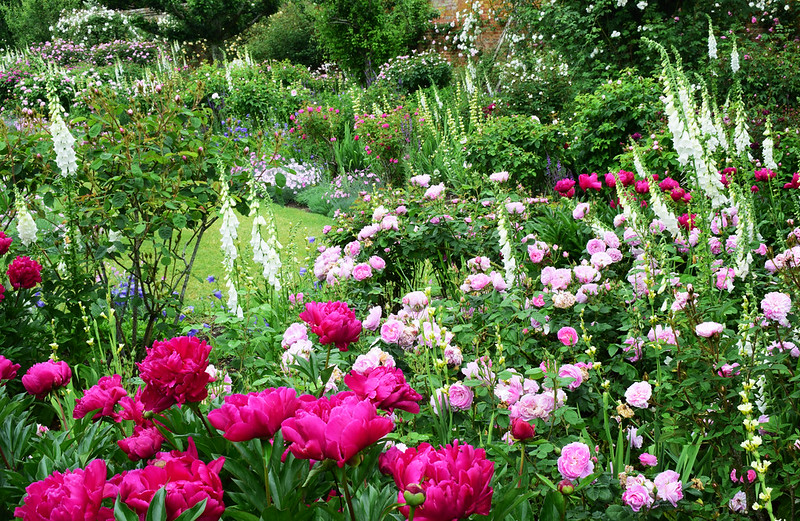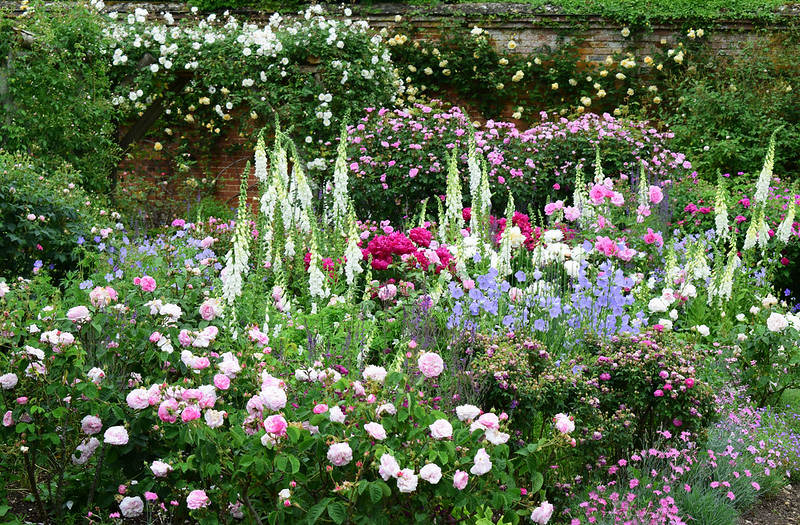Towering flower spikes and bell-shaped blooms with speckled interiors make the foxglove a stand-out plant to include in a landscape. This low-maintenance perennial grows in zones 4 through 10 and can reach up to 6 feet tall, depending on the variety. A mass of foxglove plants grouped together creates an impressive display, especially during the summer blooming season, but these flowering perennials also work well in a curated space.
Mix foxglove throughout a garden bed so the tall flower spikes appear randomly. Feature different varieties of foxglove that reach varying heights to add more dimension.
Plant foxglove in full sun, although afternoon shade is best in hot climates. The soil should be well draining but consistently moist. These adaptable care requirements work for a lot of landscape plants, making foxglove a good companion in a shared space.

Photo by Mark Wordy, unmodified, Flickr, copyright CC BY 2.0 DEED
Shrubs To Plant With Foxglove
Create a space teeming with flowers by planting foxglove with roses or hydrangeas. Roses and hydrangeas bloom during the spring, summer, or fall, depending on the cultivar. Choose a variety that blooms at the same time for flowers all at once, or select a cultivar that blooms at a different time so there are always flowers to enjoy.
Make foxglove a focal point by pairing this flowering perennial with boxwood. The glossy evergreen boxwood foliage creates a lovely background for the bell-shaped foxglove flowers. Use boxwood to create a border or hedge and plant foxglove in front so the tall flower spikes stand out. Boxwood can be pruned to maintain a formal shape, but if you want something more organic in appearance, try yew. Depending on the type, this coniferous shrub can have a small round or a tall columnar form.
Perennials To Plant With Foxglove
The mounded form of Dianthus grows best in full to partial sun. The flowers are not large, but this plant is a prolific bloomer, so it makes a significant visual impact. Salvia is another prolific bloomer, but it grows taller than Dianthus, so it fills in more vertical space when planted near tall foxglove varieties. Plant Dianthus, Salvia, and Foxglove to create a tiered, meadow-inspired space.
Columbine is another tall plant that can reach several feet high, adding height to a mass planting. Enjoy the unique back-bending flowers of the Columbine during the spring and early summer. The Columbine’s flowers will dazzle while the foxglove is still growing, so there is consistent interest and support for pollinators. Peony is another perennial that puts on an impressive display during the spring. The large peony flowers fade before the foxglove blooms, but the foliage stays in place, creating a nice background for the foxglove to stand out.

Photo by Mark Wordy, unmodified, Flickr, copyright CC BY 2.0 DEED
Annuals To Plant With Foxglove
Plant alyssum along the base of the foxglove to fill the space. Alyssum is a spring bloomer, but it can re-bloom in the fall, so it bookends the foxglove’s bloom schedule. Lobelia is a flowering annual with a full, mounded form. The tubular blooms and spreading petals provide texture and contrast to the foxglove flowers. This plant blooms throughout the growing season but does not bloom as prolifically during hot summer weather.
Best Companion Plants For Foxglove in Containers
The bellflower plant's bell-shaped flowers slightly mimic the foxglove blooms' shape for a cohesive appearance. Creeping, groundcover types spread, and the stems will tumble over the edge of the container, working as a filler and spiller to the foxglove’s upright thriller role. Petunias also make a wonderful container companion since this annual blooms all season. Petunias, bellflowers and foxgloves do best with routine watering to keep them lush and encourage more blooming.
Plants Not To Grow With Foxglove
Foxglove is adaptable and can live in various conditions, but full to partial sun and routine watering is best for this plant to thrive. Plants with drastically different care needs are not good companion plants for foxglove. Shade-loving plants like impatiens and coral bells will not grow well with foxglove. Likewise, plants that prefer dry conditions, like sedum, are not a good match.
Best Plants To Grow With Foxglove
Foxglove is an excellent perennial to add height to a mixed bed that receives full to partial sun. While this plant can handle damp soil, it does not like soggy conditions. Hydrangea, rose, Columbine, Dianthus, and Salvia do best in a sunny spot but also appreciate routine waterings, making them good companions for foxglove.
 |
Author Robbin Small - Published 10-16-2023 |
